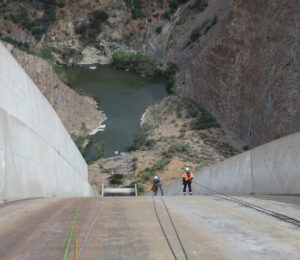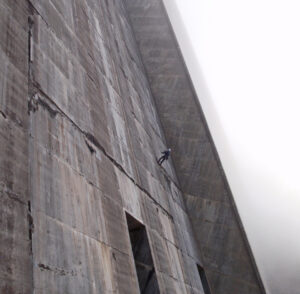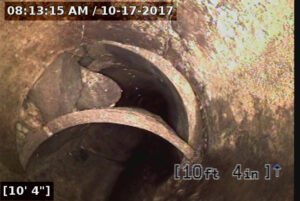In February 2017, the service spillway of California’s Oroville Dam was damaged, resulting in an emergency that required the temporary evacuation of 188,000 people downstream. While the danger was contained and the spillway was reconstructed the following year, the Oroville incident was serious enough to provoke a thorough rethink of dam maintenance and inspection practices across California and nationwide. The personnel of engineering firm HDR, Inc., were onsite at Oroville Dam and played a major role both in responding to the initial damage and in developing new methods and practices for dam and spillway inspection. In this interview, HDR Principal Hydraulic Structures Engineer Sam Planck and Hydraulic Structures Practice Leader Kenny Dosanjh tell Municipal Water Leader about their work promoting dam safety in the aftermath of the Oroville spillway incident.
Municipal Water Leader: Please tell us about your backgrounds and how you came to be in your current positions.
Sam Planck: My background is primarily in hydraulic structures. I’ve been with HDR for 30 years. The way I usually describe my work is that I’m engaged with the steeland-concrete end of water resources. This could be tied to dam safety, flood control, or fisheries. My work typically focuses on all those pieces at a dam site that aren’t the actual dam. I’ve been in my current role managing one of the California Department of Water Resources’ (DWR) dam safety contracts for HDR for about 6 years. Before that, I managed the hydraulic structures group at HDR.
Kenny Dosanjh: I’m HDR’s hydraulic structure practice leader. I’ve been with the company for 15 years now. My background has focused heavily on rope-access inspections for various types of structures, including radial gates, spillways, and one-off structures like outlets and intake structures. I’ve also done a lot of finite element analysis of various hydraulic structures and design and repairs of flood walls, gates, and spillways. I was the dams and hydraulics structures section manager for approximately 4 years.

Municipal Water Leader: What services does HDR perform with regard to dams?
Sam Planck: It’s a pretty extensive list. Some of the more traditional items on it would be inspection, analysis, and design. We also do a significant amount of dam safety work related to potential failure mode analyses, risk assessments, and the development of dam safety training learning tools. We also conduct hydraulic, geotechnical, and structural analyses.
Kenny Dosanjh: As Sam said, we are involved in every single discipline associated with dams, from geotechnical investigations to developing potential maximum precipitation and potential maximum flood updates. Because we’re involved in the structural work for dams, we also get involved in the related civil work, such as construction support and site civil engineering, including access roads, drainage, and grading.
Municipal Water Leader: Would you tell us about the 2017 Oroville Dam spillway incident? What occurred, and why?
Sam Planck: It’s believed that the event began with damage to the spillway slab. The deterioration of the slab concrete at the joints, combined with the pressure that accompanies high-velocity water on such a spillway, eventually took a small piece of concrete out of the spillway floor. Once there was a disruption in that flow, the cavitation forces and pressures began to damage the rest of the spillway. As larger and larger pieces of it were dislodged, the foundation and chute walls were further eroded and eventually collapsed, providing a new outlet for the water to spill down and further erode the hillside.
Municipal Water Leader: What was HDR’s role in the response to the incident?
Sam Planck: Prior to that incident, HDR had been working with the California DWR, under one of its damsafety contracts, to provide a variety of services, including inspection analyses, studies, and hydrology and hydraulics work. When the spillway incident occurred, our role was to support DWR’s internal dam safety group. Specifically, we were asked to provide a significant number of monitors along with extensive consulting. We had over 150 personnel on site, split into crews, working 24 hours a day, 7 days a week, for 6 months. Their initial objective was to monitor the progression of the head cutting and then to observe the remainder of the spillway and other elements that could have been affected by the event. It was the most interesting and the most challenging period of my career. The level of resourcing and staffing and the number of things that were changing at any given time were unprecedented. While I was working more behind the scenes, lining up the resources, Kenny had a firsthand view of what was happening.
Kenny Dosanjh: I was called up the day it happened. I remember Les Harder telling me that something was going on with the spillway and asking if I could grab some inspection gear and go up to the dam with him. When we arrived, I saw the extent of the initial damage area and realized that everything I had brought was pretty much useless. We were the first people to actually go into the damage area of the spillway, and by the next day we were thrust into leading DWR’s assessment efforts.

Our objective was to quantify the damage within the initial damage area and then develop ideas to keep further damage from occurring. We collected a number of rock samples to try to get a better understanding of what the makeup of the exposed foundation material was. We needed to figure out if the foundation would be susceptible to head cutting and whether the spillway foundation would continue to erode upstream. This information was helping inform us of what the ramifications might be from a continued release over the damaged spillway. We continued relaying data back to Sam and the team at the office, who were doing real-time analysis. They used our imagery and videos from the field to calibrate the models they were developing, with the underlying objective of having the best idea of what could happen and how best to ensure everyone’s safety in the meantime.
Municipal Water Leader: What new spillway reliability and performance practices has HDR developed and introduced in response to the Oroville incident?
Kenny Dosanjh: The Oroville incident showed how important it is to create a baseline document and a baseline condition assessment for spillways in order to have something to compare future assessments to. That practice is probably one of the biggest things that HDR helped introduce to the industry following Oroville. In the wake of Oroville, it was apparent that spillways generally didn’t have such baselines, meaning that we couldn’t tell whether the structure had changed over time. These baseline assessments should identify deficiencies and determine whether they require immediate repair or close monitoring through regular inspections. A critical component of all this is understanding the original design and looking at whether anchors, water stops, or other features are in place to help with spillway functionality. The next step is to take all those initial design criteria and compare them to our standards today; that helps you understand your spillway, what could happen to it, and what can be done to maximize its operational capabilities and safety. Looking at the initial structural design can also signal potential failure modes, both under general operating conditions and in the case of unusual events such as seismic activity. These things have not necessarily been done routinely in the past. The industry was previously focused on the potential failure modes of actual dams, but in the wake of the Oroville incident, we’re emphasizing the spillway as well.
Municipal Water Leader: What are some of the other problems you have found in spillways built in the 1960s and 1970s?
Sam Planck: One of the biggest surprises has been that there are problems with the condition of underdrains, which are usually a series of clay pipes that lie underneath the concrete slabs in spillways. These clay pipes have a series of holes that allow pressure building up under the slabs to drain out. They are difficult to get to because they’re buried, and as a result, they are rarely inspected. Over the last couple of years, we’ve been using everything from crawling submersible robots to push cameras to inspect miles of underdrain in spillways across the country. We’ve been quite surprised by the number of pipes that are broken or somehow blocked. Many of them have also been identified as undersized and thus ineffective. In addition to video inspections, we have conducted dye testing and smoke testing to determine whether they are able to dissipate water pressure. Along with these inspections, we take
measurements to identify joint offsets that could disrupt drain flows or otherwise erode the pipes themselves. Remediation in these situations can often be as simple as refilling the joints or grinding down a high spot so that it doesn’t disrupt the high-speed water. Another approach that avoids disrupting or tearing up any part of the structure is to use groundpenetrating radar to look for voids in the foundation beneath the concrete slab and to identify deficiencies in the concrete— essentially, layers within the concrete that are not performing correctly. If we identify something via these noninvasive methods, then we can drill a small hole into the concrete and run cameras down to find out if there really are voids and how well the slab is connected to the foundation material.
Municipal Water Leader: Would you tell us about other dam inspections that HDR has been involved with?
Sam Planck: As we noted earlier, HDR conducts a variety of types of hydraulic structure work and dam inspections. Historically, a lot of our work has dealt with gate inspections. About 20 years ago, we formed a rope-access climbing team for this specific purpose. It has performed inspections on thousands of gates all over the country over the last couple of decades. HDR has done over 100 spillway inspections across the nation since Oroville. Some require the rope team, while others are done on foot. Some of the spillways that have been inspected are enormous, while others are not much larger than a driveway. In every case, they receive the same type of inspection. I would say 20–25 percent of those inspections lead to some type of retrofitting or remediation or even the replacement of portions of the structure.
Municipal Water Leader: Has HDR done any research on the seismic vulnerability of dams around the nation?
Sam Planck: Yes, we do quite a bit of seismic analysis. The kind of analysis that is done depends on whether you are looking at the dam as a whole or at a piece of it, such as its spillway. We’re currently doing seismic analyses of spillways for a number of clients. Obviously, an analysis of the dam itself is even a bigger undertaking and can often involve more complicated computer models that can do things like nonlinear analysis.
Kenny Dosanjh: We’re relying on programs such as ANSYS and LS-DYNA to perform this work. We are not just focusing on the model of the actual dam; rather, we are using Bureau of Reclamation standards and spanning out thousands of feet to the sides of or underneath the dams. We’re modeling in foundation conditions, water, and terrain and even initiating a seismic force underneath the dam in the model and allowing it to propagate up. HDR is one of the leaders in this approach.
Municipal Water Leader: Would you tell us about how the Federal Energy Regulatory Commission (FERC) and the California DWR’s Division of Safety of Dams (DSOD) rewrote dam safety investigation requirements?

Sam Planck: A lot of that rewriting is still going on, and the regulatory environment varies by state and structure. FERC regulations, for example, only apply to dams that generate power. If the dam doesn’t generate power but has a spillway, it falls under state jurisdiction; in California, for instance, it would fall under the jurisdiction of the DSOD. California has a strong dam safety regulator in DSOD with a lot of knowledgeable people on staff, while other states may have only a handful of people assigned to this area who furthermore may not have a great deal of experience with dams. Therefore, this first round of spillway inspections across the nation will definitely influence how these regulations develop. The techniques that reveal the most defective conditions will probably end up being prescribed by regulations, while those that do not reveal as much valuable information may well not end up in the regulations.
Municipal Water Leader: How has HDR been helping dam owners adapt their inspection programs?
Kenny Dosanjh: One of the biggest things is to create a periodic inspection checklist. This can work in conjunction with the baseline condition analyses we discussed earlier. Dam owners can go through their checklists, looking for certain items, taking certain measurements, and even making
observations by drone, in order to compare current conditions to the baseline. That’s one of the most significant initiatives that emerged from the Oroville incident. Another was the new emphasis on underdrain review and the remediation protocols we developed. This led to the much more rigorous inspection and maintenance objectives that we insist on today. Another big thing is the new emphasis on dewatering systems. Spillway terminations are often covered with water for 100 percent of their lifetime. Even with flip buckets, there will often be drains that are clogged to one degree or another. That can cause some pretty bad things in terms of deterioration. Dewatering at 50-year intervals is no longer appropriate considering what we now know and the tools and techniques we have at our disposal today.
Sam Planck: A significant aspect of this revolves around altering mindsets about dam programs. For example, it is important to convince people to think of a spillway as a machine. Machines need to be inspected and when necessary, remediated.
Municipal Water Leader: What is your vision for the future of dam safety?
Sam Planck: There’s going to be a lot more attention paid to risk and risk-informed decisionmaking. A lot of the things that were revealed by the Oroville incident imply really expensive decisions for dam owners going forward. Whether to retrofit one part of a dam or another could be a multimillion- or multibillion-dollar decision. Knowing which project could most significantly reduce risk can help determine the relative value of such expenditures.
“The Oroville Spillways Emergency Recovery Project demonstrated the value of DWR’s partnerships with key organizations. Being prepared with an agreement among all key players certainly helped the project run more smoothly. There were many challenges and the team was ready to find solutions before t hey became setbacks.”
—Ted Craddock, acting State Water Project deputy director, California Department of Water Resources
Sam Planck, PE, is a vice president and principal hydraulic structures engineer at HDR in Folsom, California. He can be contacted at sam.planck@hdrinc.com.
Kenny Dosanjh, PE, is an associate hydraulic structures practice leader and rope access dam inspection program lead at HDR in Sacramento, California. He can be contacted at kenwarjit.dosanjh@hdrinc.com.
